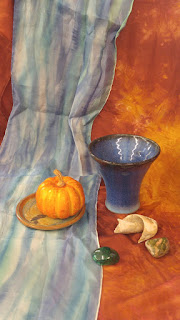What a lovely room! Set in the woods, with large windows overlooking a cavernous ravine, the view was moody and spectacular really. I immediately though this would be a great space for a winter landscape class. We quickly set up and spent the next 2 days busily creating art.
the full value study; and the accompanying pastel
This was the first time teaching this particular workshop. I LOVE planning workshops. This one came out of the observation that my students are anxious to get going on a painting and miss some of the key stages of planning out a good painting.
This was a two day workshop. WE spent the entire first day setting up still life in a credible composition, with good lighting and backdrops. Everyone worked in pairs or three, to create the various set ups.
The various set ups
After a review of composition, I did a demo of a set up, in a 3 value study, large. Not a thumbnail, or,...the largest thumbnail you've ever seen! To create a complete value study is to make the artist responsible for a composition plan in every part of the picture plane. By making this study large, or the same size as the pastel to come, we are using this stage of preparation to weed out any composition problems that will weaken the entire plan. It also helps us visualize our plan, and get us thinking about colour as we assign value everywhere.

Students used the afternoon to work up these studies. We spent a good amount of time talking about grounds, the paper we'll use in pastel. Sanded or not? But the biggest effect is colour. What colour will enhance our limited palette that we begin all our paintings with? What ground colour will enhance the initial idea we had, creating the mood or feeling we want to get across as artists.
Taking time in each of these stages, playing here and asking, what if? on colour, moving objects around to create more flow, and making a satisfying arrangement of values. These steps will greatly improve the quality of your work before you even start in with pastel.
taking the time to really play with colour and choose a satisfying palette.
WIP: And then, the pastel work.
same scene, slightly different angle and completely different palette.
Penny, on her way, working on a dark red sanded surface.
Ann: the ultimate experimenter, capturing the essence of the rock.
Over my years of teaching, i have observed many artists working slow, it's their nature. Then you also meet those who work fast, creating many pieces in the same timeframe others created one painting. No right or wrong, just different natures.
This artist was very careful with every stage of the work, producing a really lovely, simple yet powerful composition.
Experimenting with a dark and intense colour, harmony happened right off the batt, green, turquoise, and sienna.
working out the details, reflections, etc.
Same artist, two differentness papers creating different moods.
Just one version of the ever morphing rock under Anns' tutelage.



















